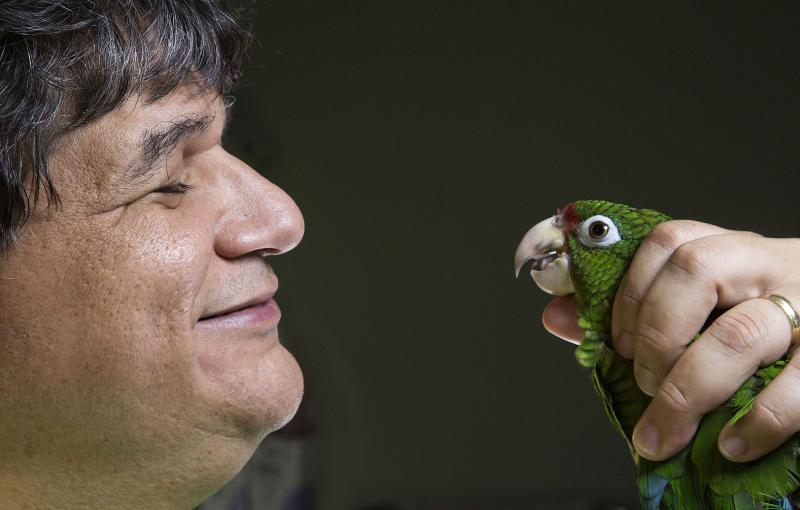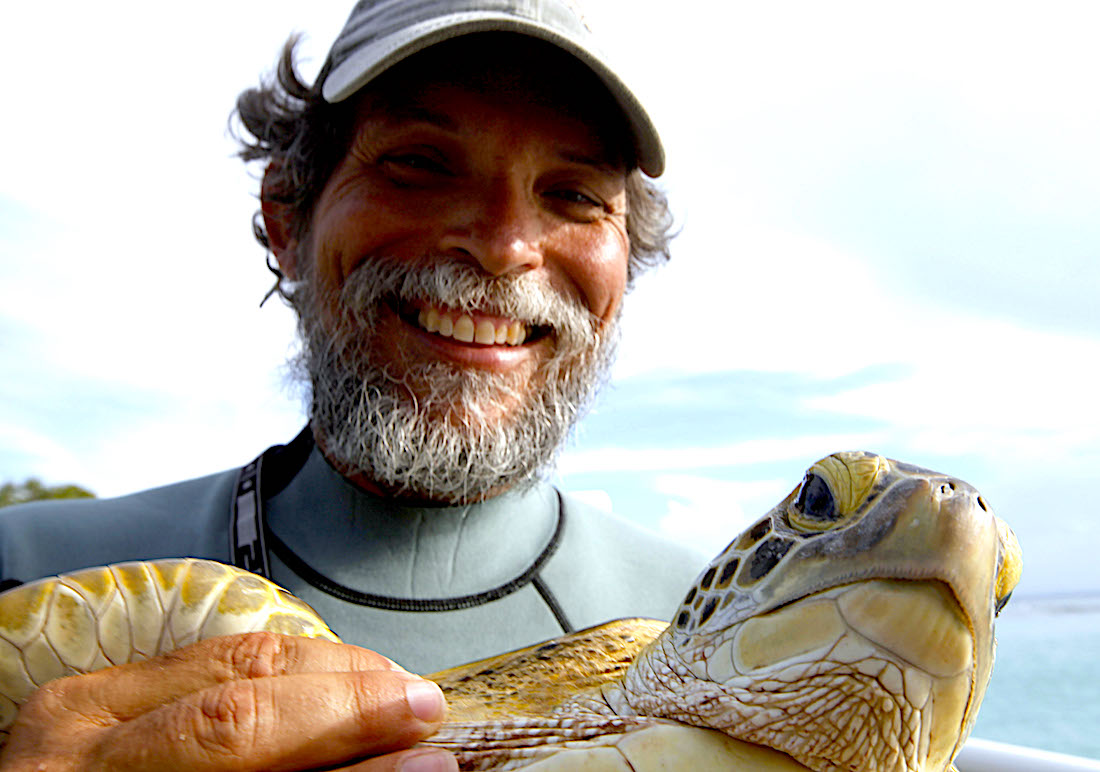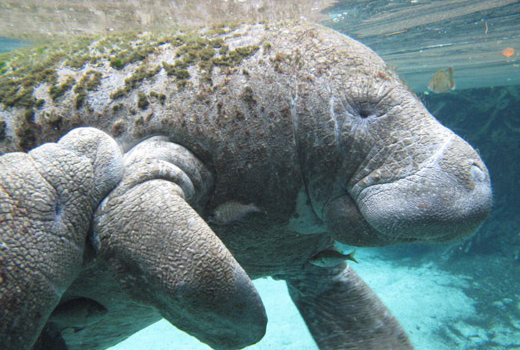Puerto Rico: Island of Enchantment – Natural World, BBC Two | reviews, news & interviews
Puerto Rico: Island of Enchantment – Natural World, BBC Two
Puerto Rico: Island of Enchantment – Natural World, BBC Two
Caribbean conservationists fight back against man-made mayhem

The soothing voice of David Attenborough narrated this cautionary tale, which is improbably heading not for a happy ending but a happy new beginning. Puerto Rico, the so-called island of enchantment, overwhelmed early western visitors with its charms: its beaches, its rainforest, its animals, its beauty.
Heavy industrialisation and urbanisation were to follow, wrecking the previously pristine environment. Scientists reckon 95 percent of the original rainforests have been lost, well down from the mere 50 percent a century ago. But, hey, 60 percent of it is on the way to recovery, and all from an upswelling of interest from the community itself; and a greening Puerto Rico can’t be bad for tourism (pictured below, Carlos Diez with Hawksbill turtle). We followed three dedicated conservation teams, in it as a vocation rather than a job and depending on science, rehabilitation and even seduction – we saw aviaries providing the right surroundings for threatened parrots to make love, for reproductive purposes. This past year has been exemplary with conservationists, vets and volunteers collaborating to bring native animals back from the brink. The figures are disturbing, to put it mildly. Not long ago, only 13 Puerto Rican Amazon parrots were believed to be left in the wild. Now there are 200, and we witnessed the encouraging work at the conservation flight school, where young birds have to be able to fly for at least three minutes to escape any avian predator. Twenty-four passed muster for release into the wild, which it is hoped will boost species viability by 10 percent.
We followed three dedicated conservation teams, in it as a vocation rather than a job and depending on science, rehabilitation and even seduction – we saw aviaries providing the right surroundings for threatened parrots to make love, for reproductive purposes. This past year has been exemplary with conservationists, vets and volunteers collaborating to bring native animals back from the brink. The figures are disturbing, to put it mildly. Not long ago, only 13 Puerto Rican Amazon parrots were believed to be left in the wild. Now there are 200, and we witnessed the encouraging work at the conservation flight school, where young birds have to be able to fly for at least three minutes to escape any avian predator. Twenty-four passed muster for release into the wild, which it is hoped will boost species viability by 10 percent.
No such programme is complete without some squirm-making operation: here it was examining under anaesthetic the testicles of one parrot and the ovaries of his mate, as they were not reproducing. Parrots mate for life, so it took some human finesse to arrange a divorce; the male became a father and the divorcée became a successful foster mother. In one of those tense moments of eat-or-be-eaten, a Puerto Rican boa snuck into the family’s cage, but the alert, squawking parrots were more than a match for the opportunistic snake.
 For the parrots, the problem was the loss of the rain forest. But for the manatees (pictured left), those serene herbivorous long-living sea cows, it was assault by motor-craft. The gorgeous ocean bays are naturals for recreational speedboats, a marine motorway whose casualties are manatees. Eleven miles inland the manatee conservation centre rehabilitated the wounded, and succoured the orphans. One manatee was too injured to ever be able to swim in the wild again. The climatic celebration saw two orphans finally released back into the ocean after a five-year rehabilitation, cheered on by everyone from the police to hysterically happy volunteers.
For the parrots, the problem was the loss of the rain forest. But for the manatees (pictured left), those serene herbivorous long-living sea cows, it was assault by motor-craft. The gorgeous ocean bays are naturals for recreational speedboats, a marine motorway whose casualties are manatees. Eleven miles inland the manatee conservation centre rehabilitated the wounded, and succoured the orphans. One manatee was too injured to ever be able to swim in the wild again. The climatic celebration saw two orphans finally released back into the ocean after a five-year rehabilitation, cheered on by everyone from the police to hysterically happy volunteers.
And of course the sea turtles: the endangered Hawksbill, hunted for its flesh and its gorgeous shell, now protected, and the Leatherbacks, the world’s largest turtles who weigh a mere half ton and can grow to six feet or more. The favoured beach for their nests – 80 eggs at a time, the size of tennis balls – was called Dorado, and guess what, property developers had their eye on it. Conservationists, campaigners, volunteers and schoolchildren all trooped to court to get a conservation order. A very poised schoolgirl testified that without the Leatherback turtle, the growth of the jellyfish population would ensure no one could safely swim off the beach anyway.
Why do so many of us love nature programmes so much? Is it the optimism of some human beings valiantly trying to undo the harm others have done to the world around us? Or is it the infinite variety of life in all its diverse forms, struggling on amid a nature red in tooth and claw? This programme stuffed with facts, with people happy in the jobs they were doing and its rehabilitated manatees and parrots, was armchair travel at its best.
rating
Explore topics
Share this article
The future of Arts Journalism
You can stop theartsdesk.com closing!
We urgently need financing to survive. Our fundraising drive has thus far raised £49,000 but we need to reach £100,000 or we will be forced to close. Please contribute here: https://gofund.me/c3f6033d
And if you can forward this information to anyone who might assist, we’d be grateful.

Subscribe to theartsdesk.com
Thank you for continuing to read our work on theartsdesk.com. For unlimited access to every article in its entirety, including our archive of more than 15,000 pieces, we're asking for £5 per month or £40 per year. We feel it's a very good deal, and hope you do too.
To take a subscription now simply click here.
And if you're looking for that extra gift for a friend or family member, why not treat them to a theartsdesk.com gift subscription?
more TV
 Murder Before Evensong, Acorn TV review - death comes to the picturesque village of Champton
The Rev Richard Coles's sleuthing cleric hits the screen
Murder Before Evensong, Acorn TV review - death comes to the picturesque village of Champton
The Rev Richard Coles's sleuthing cleric hits the screen
 Black Rabbit, Netflix review - grime and punishment in New York City
Jude Law and Jason Bateman tread the thin line between love and hate
Black Rabbit, Netflix review - grime and punishment in New York City
Jude Law and Jason Bateman tread the thin line between love and hate
 The Hack, ITV review - plodding anatomy of twin UK scandals
Jack Thorne's skill can't disguise the bagginess of his double-headed material
The Hack, ITV review - plodding anatomy of twin UK scandals
Jack Thorne's skill can't disguise the bagginess of his double-headed material
 Slow Horses, Series 5, Apple TV+ review - terror, trauma and impeccable comic timing
Jackson Lamb's band of MI5 misfits continues to fascinate and amuse
Slow Horses, Series 5, Apple TV+ review - terror, trauma and impeccable comic timing
Jackson Lamb's band of MI5 misfits continues to fascinate and amuse
 Coldwater, ITV1 review - horror and black comedy in the Highlands
Superb cast lights up David Ireland's cunning thriller
Coldwater, ITV1 review - horror and black comedy in the Highlands
Superb cast lights up David Ireland's cunning thriller
 Blu-ray: The Sweeney - Series One
Influential and entertaining 1970s police drama, handsomely restored
Blu-ray: The Sweeney - Series One
Influential and entertaining 1970s police drama, handsomely restored
 I Fought the Law, ITVX review - how an 800-year-old law was challenged and changed
Sheridan Smith's raw performance dominates ITV's new docudrama about injustice
I Fought the Law, ITVX review - how an 800-year-old law was challenged and changed
Sheridan Smith's raw performance dominates ITV's new docudrama about injustice
 The Paper, Sky Max review - a spinoff of the US Office worth waiting 20 years for
Perfectly judged recycling of the original's key elements, with a star turn at its heart
The Paper, Sky Max review - a spinoff of the US Office worth waiting 20 years for
Perfectly judged recycling of the original's key elements, with a star turn at its heart
 The Guest, BBC One review - be careful what you wish for
A terrific Eve Myles stars in addictive Welsh mystery
The Guest, BBC One review - be careful what you wish for
A terrific Eve Myles stars in addictive Welsh mystery
 theartsdesk Q&A: Suranne Jones on 'Hostage', power pants and politics
The star and producer talks about taking on the role of Prime Minister, wearing high heels and living in the public eye
theartsdesk Q&A: Suranne Jones on 'Hostage', power pants and politics
The star and producer talks about taking on the role of Prime Minister, wearing high heels and living in the public eye
 King & Conqueror, BBC One review - not many kicks in 1066
Turgid medieval drama leaves viewers in the dark
King & Conqueror, BBC One review - not many kicks in 1066
Turgid medieval drama leaves viewers in the dark
 Hostage, Netflix review - entente not-too-cordiale
Suranne Jones and Julie Delpy cross swords in confused political drama
Hostage, Netflix review - entente not-too-cordiale
Suranne Jones and Julie Delpy cross swords in confused political drama

Add comment